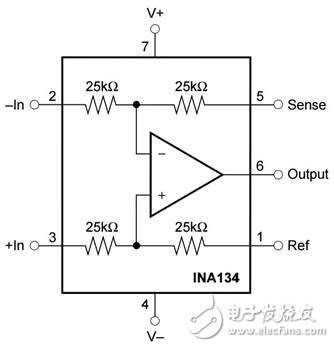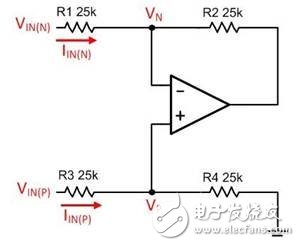The monolithic differential amplifier is an integrated circuit, including an operational amplifier (op amp) and no less than four precision resistors in the same package. They are very useful building blocks for analog designers who need to convert differential signals into single-ended signals while suppressing common-mode signals. For example, the INA134 shown in Figure 1 is intended to be used as a line receiver suitable for differential audio interfaces. Figure 1 : Simplified internal schematic diagram of INA134 differential line receiver Although most designers feel that such simple building blocks are very easy to use, I still find that there is one aspect that is often overlooked when using them: the two input terminals of the differential amplifier have different effective input resistances. The "effective input resistance" mentioned by the author refers to the input resistance generated by the resistance of the internal resistor and the operation of the operational amplifier. Figure 2 shows a typical configuration of the INA134, with marked input voltage and current, and the voltage at the input node of the internal op amp. Figure 2 : The relevant voltage and current used in the analysis of the effective input resistance of the differential amplifier For each input terminal, Equation 1 interprets the effective input resistance as: Let's start with the easier part: the non-inverting input. Looking at the schematic diagram in Figure 2, you will find that R3 and R4 are connected in series. Assuming that no current enters or leaves the input of the op amp, the effective input resistance calculated by Equation 2 is only: Now, let's focus on the inverting input. Recall the ideal op amp rule: the two inputs of the op amp should always be at the same potential (Equation 3): You can also see that R3 and R4 form a voltage divider at the non-inverting input. The voltage at the non-inverting input (V P ) of the op amp calculated by Equation 4 is: Why is this important? Oh, because this voltage partly determines the effective input resistance of the inverting input. Consider that the current through R1 (I IN ( N ) ) is equal to the voltage across R1 divided by its resistance (Equation 5): Going back to Equation 1, and substituting Equation 5 for the input current, you can get Equation 6-a general equation that can calculate the inverting input resistance: Now that you know that the voltage at the inverting input terminal (V N ) will be equal to the voltage at the non-inverting input terminal (V P ), you can replace V N in Equation 6 with Equation 4 to get Equation 7: Note that the effective input resistance of the inverting input actually depends on the ratio of the two input voltages. To understand how this can affect your application, consider an example: an INA134 used in an audio line receiver application, where the voltage amplitudes at the two inputs are equal but opposite in polarity (Equation 8): Looking back at Equation 2, the effective input resistance of the non-inverting input is quite simple: However, the inverted relationship of the two input voltages will have a significant impact on the effective input resistance of the inverting input (Equation 9): The effective input resistance of the inverting input is one third of the effective input resistance of the non-inverting input. Therefore, when choosing the input coupling capacitor and filter circuit, you must consider the low impedance of the inverting input. In addition, any amplifier that drives the input of a differential amplifier must be able to drive the lower impedance of the inverting input. The use of simple circuits is often the most basic aspect of its operation and will cause trouble in the laboratory. Therefore, don't ignore the obvious! Grounding Roller and Earth Wire Stringing Block Ningbo MARSHINE Power Technology Co., Ltd. is a professional engaged in the development, design and manufacture of power engineering construction equipment and tools.
Welcome to contact MARSHINE and reach cooperation, thank you!
Grounding Roller Stringing Block,DDIN Grounded Stringing Blocks,Earth Wire Stringing Block,Wire Rope Grounding Roller Stringing Block MARSHINE , https://www.puller-tensioner.com











MARSHINE company produces circuit construction tools, including foundation construction, tower group lap. Wiring structure. Cable construction, cable construction, mobile knife mill, insulated overhead cable and high voltage Cable Stripper, all kinds of aluminum alloy pull rod, guide rail, grounding device, high strength shackle, Ratchet Wrench and pointed wrench, double hook tight line device, lifting pulley, nylon wheel and aluminum wheel, punching machine ect.
MARSHINE continues to carry forward the enterprise spirit of "integrity, development, innovation" and strive for the prosperity and development of the electric power industry.